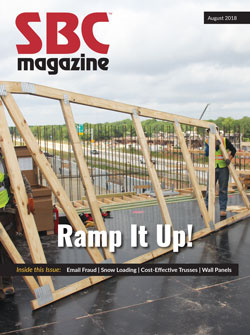Ramp It Up!
Ramp It Up!
In 2013, the Louisiana Department of Transportation (LDOT) approved plans for the state’s very first post-tensioned, precast segmental bridge as part of a modernized I-49/I-220 interchange outside Shreveport. The concrete industry was the biggest winner in the decision but Southern Components, Inc. also benefited when they were asked to provide unique trusses for a key part of the project. “This was an interesting project, definitely a big departure from designing trusses for a house,” says Danny Griffin, Southern Components lead designer for the job.
The last interstate interchange constructed in the state was built 24 years prior, and with a price tag of over $225 million, there was a lot of pressure to finish the project successfully. PCL Construction Services Inc. won the bid to act as the lead contractor, and they broke the project into three segments (J, K1 and K2) to more easily handle its incredible complexity.
The final phase (K2) involved constructing the two large bridges to connect the eastbound I-220 to the northbound I-49 (Ramp EN) and the southbound I-49 to the eastbound I-220 (Ramp SE). The initial section of Ramp EN was particularly challenging because it needed to be much wider on one end in order to accommodate a future expansion that would link the eastbound I-220 into downtown Shreveport. (See digital edition for images.)
PCL created a large area west of the new interchange to pour and store the concrete sections of the bridges until they were ready to be craned into place.
However, this approach would not work for the initial 127-foot section of Ramp EN because of its width and the need to taper its shape from 64-feet wide down to 51 feet. Danny explains, “all the pre-cast sections they were making onsite had one of only three profiles, depending on its width, so it made sense for them to mass produce those. However, this section was one-of-a-kind.”
Determining the Approach
PCL decided the easiest approach was to pour this part of Ramp EN in place, and they turned to Southern Components to provide trusses to be used in the formwork for the “wings” of the bridge section. “We were brought in because wood trusses were much more cost effective than steelwork and we could produce them quickly once they were needed," says Danny.
For most of the 120-foot length, 220 identical trusses were used. However, at either end the “wing” depth was increased from one foot to two feet to reinforce the connections, so a small group of 34 shorter trusses were used.
To accomplish the tapering of this initial portion of Ramp EN, the trusses on one side were placed in a direct line, while the trusses on the other side were set at a slight angle to create the gradual increase in width. “Given the length of the run, it wasn’t easy to tell the trusses ran at an angle until you stood in the middle and compared the size of the openings at either end,” he says.
Designing the Trusses
The loading condition for the trusses was certainly unique. “The engineer of record told me how much concrete they were going to pour and provided the loads for both the concrete and the equipment used to pour it,” says Danny. Designing for the most conservative case, both the concrete and the machinery were treated as live loads. Danny further explained, “Once the concrete begins to dry, it adheres to itself and reduces the load on the trusses. Obviously, once the concrete is cured the concrete is fully suspended.” At that point, the trusses were cut out and discarded.
“The most challenging part of the project wasn’t so much the loading conditions, it was determining the foundation they were going to set the trusses on,” says Danny. “They had to build up the ground and erect scaffolding to support the whole pour. They kept changing the parameters of how they were building it up so I had to keep going back and changing the truss profiles.” While the machinery rode right on top of the outermost vertical, the top chords of the trusses were extended to provide a platform for workers to walk on while the concrete was poured.
During production, they relied heavily on their Alpine ALS saw to put three angled cuts on each top chord to round the inside top corner of the truss as much as possible. “Before we had that capability, you’d have to start with a wider board and actually cut the curve into each one, making it a very time-consuming process,” Danny explains.
While the trusses were set, the Engineer of Record (EOR) was on the site, directing installers about when and where to install bracing. “We provided them the standard BCSI bracing guidance, but in subsequent discussions we encouraged them to assume you couldn’t ever have enough bracing,” says Danny.
The truss layout created a large chase opening for installers to work within to install bracing once the trusses were erected. The last thing anyone wanted was for the formwork to move once the concrete was poured. Danny agreed, “You really wanted to make sure the trusses couldn’t domino once all that weight was on it, that would have created a costly and time-consuming mess!”
Trusses Performed Well
The pour went smoothly and the truss systems performed exactly as intended. The overall interchange project is now entering the final stretch. LDOT tweeted on July 4 that all bridges had been connected and work had turned to finishing individual lanes and adding aesthetic elements to the bridges and columns. “I live near this interchange and have had to drive around it for a long time,” says Danny. “It was great to be a part of the project, but I’m going to be so glad when it’s finally done.”

